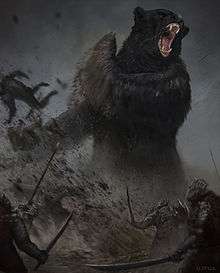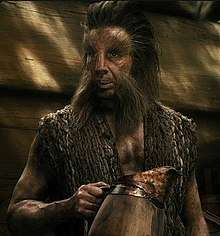Beorn
Beorn is a fictional character created by J. R. R. Tolkien, and part of his Middle-earth legendarium. He appears in The Hobbit as a "skin-changer",[T 1] a man who could assume the form of a great black bear.
| Beorn | |
|---|---|
| Tolkien character | |
| In-universe information | |
| Race | Skin-Changer |
| Book(s) | The Hobbit (1937) |
Appearances
The Hobbit

Beorn lived in a wooden house on his pasture-lands between the Misty Mountains and Mirkwood, to the east of the Anduin. His household included an animal retinue (horses, dogs, sheep, and cows, among others); according to Gandalf, Beorn did not eat his cattle, nor hunt wild animals.[T 1] He also grew large areas of clover for his bees.
Gandalf believed that Beorn was either a descendant of the bears who had lived in the Misty Mountains before the arrival of the giants, or he was a descendant of the men who had lived in the region before the arrival of the dragons or Orcs from the north.
Beorn was of immense size and strength for a man and retained his size and strength in bear-form. He had black hair (in either form) and a thick black beard and broad shoulders (in human form). While not a "giant" outright, Beorn's human form was of such great size that the three and a half foot tall Bilbo judged that he could have easily walked between Beorn's legs without touching his body. Beorn also named the large rock by the Anduin the Carrock (a name derived from the Welsh Carreg), and created the steps that led from its base to its flat top.
In The Hobbit, Beorn received Gandalf, Bilbo Baggins and 13 Dwarves and aided them in their quest to reclaim their kingdom beneath the Lonely Mountain. He was convinced of their trustworthiness after confirming their tale of encountering the Goblins of the Misty Mountains and Gandalf's slaying of their leader, the Great Goblin. In addition to giving the group much-needed supplies and lodging, Beorn gave them vital information about what path to take while crossing Mirkwood.
Later, hearing of a vast host of Goblins on the move, Beorn arrived at the Lonely Mountain in time to strike the decisive blow in the Battle of Five Armies. In his bear form he slew the Goblin leader, Bolg and his bodyguards. Without direction, the Goblin army scattered and were easy pickings for the other armies of Men, Elves, Dwarves, and Eagles. Beorn often left his home during the narrative of The Hobbit for hours or days at a time, for purposes not completely explained.
Later in The Hobbit, it is said that "Beorn indeed became a great chief afterwards in those regions and ruled a wide land between the mountains and the wood; and it is said that for many generations the men of his line had the power of taking bear's shape and some were grim men and bad, but most were in heart like Beorn, if less in size and strength."[T 2]
The Lord of the Rings
In the years between the Battle of Five Armies and the War of the Ring, possibly spurred by his interaction with Thorin's company, Beorn emerged from his reclusion and rose to become a leader of the woodmen living between the Anduin river and the fringes of Mirkwood. As stated by Glóin in The Fellowship of the Ring, the Beornings also "keep open the High Pass and the Ford of Carrock."
Some time before the War of the Ring itself began, Beorn was succeeded by his son Grimbeorn the Old. His death is not included in the chronologies in The Return of the King's appendices.
Concept and creation
In naming his character, Tolkien used beorn, an Old English word for man and warrior (with implications of freeman and nobleman in Anglo-Saxon society).[1] It is related to the Scandinavian names Björn (Swedish and Icelandic) and Bjørn (Norwegian and Danish), meaning bear; and the figure of Beorn can be related to the traditional Northern heroes Bodvar Bjarki and Beowulf, both of whose names also mean "bear".[2][3] The name of the Scottish town Borrowstounness is derived from the Old English Beornweardstun ("the town with Beorn as its guardian").[4][5]
Adaptations

Swedish actor Mikael Persbrandt portrays Beorn in Peter Jackson's The Hobbit: The Desolation of Smaug and in its sequel The Battle of the Five Armies.[7] In the film, he indicates that his people once lived in the Misty Mountains, but were conquered by the Orcs under Azog, who captured and tortured his people for sport and killed them until only one remained. Beorn eventually escaped, but still carries a chain around his wrist from his imprisonment.
In the extended edition, Beorn tells Gandalf of the alliance between the Orcs of Moria and the Necromancer of Dol Guldur, and he also inquires about the nine, who have been seen wandering near the High Fells of Rhudaur. Beorn arrives to the Battle of the Five Armies atop a Great Eagle rather than on foot and does not slay Bolg, who is killed by Legolas in the film adaptation (the Orc commander was also changed to be Azog himself, but Thorin, instead of Beorn, kills Azog in single combat).
In the DVD commentary, the production team explained that they normally take great care that characters only speak with accents which were historically present in the British Isles, but they made a major exception for Beorn by letting Persbrandt use his natural Swedish accent. They reasoned that Beorn should logically have a very distinctive and foreign-sounding accent, given that he is the last survivor of an isolated race which had little contact with people from regions such as Gondor or the Shire.[8]
Jackson stated that many actors were auditioned for the role, but Persbrand captured its primitive energy. Richard Armitage, who played Thorin Oakenshield, said that Persbrand had a fantastic voice, and that his accent was perfect for the role.[6]
In the 2003 video game adaptation the original encounter with Beorn at his lodge is omitted. Nevertheless, he still shows up at the Battle of Five Armies to kill Bolg. Beorn only appears in bear form in the game.
The Beornings appear as trainable units in The Lord of the Rings: War of the Ring (2003). The Beornings were added as a playable class to the massively multiplayer online role-playing game The Lord of the Rings Online in Update 15 (November 2014). The players can play as a male or a female Beorning and can transform into a bear after building up sufficient wrath whilst engaged in combat. Grimbeorn's Lodge in the Vales of Anduin has also been added to the game as a starter area for the Beorning class and Grimbeorn himself also makes a brief appearance.
See also
- Beorn leggi, a species of extinct tardigrades named after Beorn
- Berserker, Viking warriors who wore the skins of bears into battle
References
Primary
- This list identifies each item's location in Tolkien's writings.
- Tolkien 1937, ch. 7 "Queer Lodgings"
- Tolkien 1937, ch. 18 "The Return Journey"
Secondary
- See definition: Bosworth, Joseph; Toller, T. Northcote. "BEORN". An Anglo-Saxon Dictionary (Online). Prague: Charles University., cognate to the Swedish and Icelandic björn
- Shippey 2001, pp. 31-32.
- Shippey 2005, p. 77.
- Hanks, Patrick; Hodges, Flavia; Mills, A. D.; Room, Adrian (2002). The Oxford Names Companion. Oxford: the University Press. p. 951. ISBN 0198605617.
- Ross, David. Dictionary of Scottish Place-Names. Birlinn. p. 15.
- Löwenskiold, Ebba (10 December 2012). "Persbrandt hyllas för sin roll i "Hobbit"" [Persbrandt is praised for his role in The Hobbit]. Expressen (in Swedish).
Richard Armitage (Thorin): - Han har en fantastisk röst - för mig är rösten 80 procent av en karaktär. Hans accent var perfekt för rollen.
- Dunerfors, Alexander. "Persbrandt åker tillbaka för mera "Hobbit"" [Persbrandt goes back for more "Hobbit"]. MovieZine (in Swedish). Retrieved 10 December 2015.
- The Hobbit: The Desolation of Smaug, DVD Commentary.
Sources
- Shippey, Tom (2001). J. R. R. Tolkien | Author of the Century. HarperCollins. ISBN 978-0261-10401-3.CS1 maint: ref=harv (link)
- Shippey, Tom (2005) [1982]. The Road to Middle-Earth (Third ed.). Grafton (HarperCollins). ISBN 978-0261102750.CS1 maint: ref=harv (link)
- Tolkien, J. R. R. (1937), Douglas A. Anderson (ed.), The Annotated Hobbit, Boston: Houghton Mifflin (published 2002), ISBN 0-618-13470-0